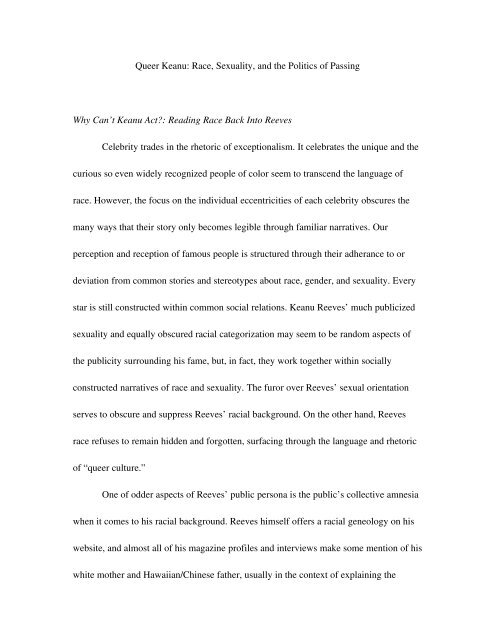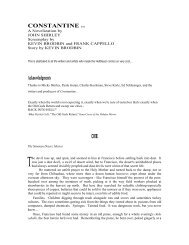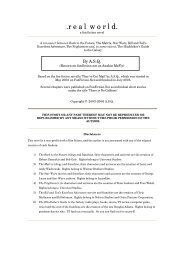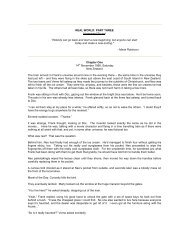Queer Keanu: Race, Sexuality and the Politics of - Whoa is (Not) Me
Queer Keanu: Race, Sexuality and the Politics of - Whoa is (Not) Me
Queer Keanu: Race, Sexuality and the Politics of - Whoa is (Not) Me
You also want an ePaper? Increase the reach of your titles
YUMPU automatically turns print PDFs into web optimized ePapers that Google loves.
<strong>Queer</strong> <strong>Keanu</strong>: <strong>Race</strong>, <strong>Sexuality</strong>, <strong>and</strong> <strong>the</strong> <strong>Politics</strong> <strong>of</strong> Passing<br />
Why Can’t <strong>Keanu</strong> Act?: Reading <strong>Race</strong> Back Into Reeves<br />
Celebrity trades in <strong>the</strong> rhetoric <strong>of</strong> exceptional<strong>is</strong>m. It celebrates <strong>the</strong> unique <strong>and</strong> <strong>the</strong><br />
curious so even widely recognized people <strong>of</strong> color seem to transcend <strong>the</strong> language <strong>of</strong><br />
race. However, <strong>the</strong> focus on <strong>the</strong> individual eccentricities <strong>of</strong> each celebrity obscures <strong>the</strong><br />
many ways that <strong>the</strong>ir story only becomes legible through familiar narratives. Our<br />
perception <strong>and</strong> reception <strong>of</strong> famous people <strong>is</strong> structured through <strong>the</strong>ir adherance to or<br />
deviation from common stories <strong>and</strong> stereotypes about race, gender, <strong>and</strong> sexuality. Every<br />
star <strong>is</strong> still constructed within common social relations. <strong>Keanu</strong> Reeves’ much publicized<br />
sexuality <strong>and</strong> equally obscured racial categorization may seem to be r<strong>and</strong>om aspects <strong>of</strong><br />
<strong>the</strong> publicity surrounding h<strong>is</strong> fame, but, in fact, <strong>the</strong>y work toge<strong>the</strong>r within socially<br />
constructed narratives <strong>of</strong> race <strong>and</strong> sexuality. The furor over Reeves’ sexual orientation<br />
serves to obscure <strong>and</strong> suppress Reeves’ racial background. On <strong>the</strong> o<strong>the</strong>r h<strong>and</strong>, Reeves<br />
race refuses to remain hidden <strong>and</strong> forgotten, surfacing through <strong>the</strong> language <strong>and</strong> rhetoric<br />
<strong>of</strong> “queer culture.”<br />
One <strong>of</strong> odder aspects <strong>of</strong> Reeves’ public persona <strong>is</strong> <strong>the</strong> public’s collective amnesia<br />
when it comes to h<strong>is</strong> racial background. Reeves himself <strong>of</strong>fers a racial geneology on h<strong>is</strong><br />
website, <strong>and</strong> almost all <strong>of</strong> h<strong>is</strong> magazine pr<strong>of</strong>iles <strong>and</strong> interviews make some mention <strong>of</strong> h<strong>is</strong><br />
white mo<strong>the</strong>r <strong>and</strong> Hawaiian/Chinese fa<strong>the</strong>r, usually in <strong>the</strong> context <strong>of</strong> explaining <strong>the</strong>
meaning <strong>of</strong> h<strong>is</strong> name. Despite <strong>the</strong>se continual reiterations, Reeves <strong>is</strong> generally racially<br />
unmarked in both h<strong>is</strong> film roles <strong>and</strong> in public perceptions (with crucial exceptions that<br />
will be d<strong>is</strong>cussed later). An absence that <strong>is</strong> read as white. Thus Reeves <strong>is</strong> able to refer to<br />
unselfconsciously refer to himself as a “middleclass white boy.” While th<strong>is</strong> continual<br />
forgetting <strong>of</strong> race may be due, in part, to a choice <strong>of</strong> film roles, even Reeves’ appearance<br />
as a young Siddarthah in Little Buddha passed by almost unnoticed. So, too, <strong>the</strong> argument<br />
that Reeves <strong>is</strong> perceived as white because he “looks white” <strong>is</strong> a circular one since race<br />
does not simply ex<strong>is</strong>t in bodies waiting to been seen <strong>and</strong> recognized. Instead, it <strong>is</strong> our<br />
perception <strong>of</strong> racial differences that enables us to read or ignore some bodies as raced <strong>and</strong><br />
o<strong>the</strong>rs as neutral.<br />
Part <strong>of</strong> <strong>the</strong> reason Reeves racialization <strong>is</strong> so elusive lies in <strong>the</strong> swarm <strong>of</strong> gossip<br />
surrounding Reeves’ sexuality. According to DeAngel<strong>is</strong>, Reeves’ gay following started<br />
even before h<strong>is</strong> film career due, in part, to h<strong>is</strong> portrayal <strong>of</strong> a homosexual character in <strong>the</strong><br />
stage play Wolfboy. Stories <strong>of</strong> Reeves’ supposed homosexuality circulated again when he<br />
played a gay prostitute in My Own Private Idaho <strong>and</strong> reached a peak following <strong>the</strong><br />
release <strong>of</strong> Speed three years later when mainstream <strong>and</strong> gay press publ<strong>is</strong>hed rumors that<br />
Reeves married millionaire David Geffen in a secret ceremony in Par<strong>is</strong> (Robb, 180).<br />
These final rumors emphasized Geffen’s power in Hollywood <strong>and</strong> seemed to explain <strong>the</strong><br />
record contract signed by Reeves’ b<strong>and</strong>, Dogstar. As noted above, race <strong>and</strong>
homosexuality tend to cancel each o<strong>the</strong>r out in <strong>the</strong> public imagination so <strong>the</strong> widely<br />
spread rumors <strong>of</strong> homosexuality can literally blind many viewers to racial differences.<br />
Even as one might argue that Reeves’ rumored sexuality erases a racial reading <strong>of</strong><br />
Reeves, <strong>the</strong> opposite <strong>is</strong> also true. The innuendo surrounding h<strong>is</strong> sexuality simultaneously<br />
articulates <strong>the</strong> repressed <strong>and</strong> forgotten racial difference that, like <strong>the</strong> neurotic’s<br />
symptoms, returns again <strong>and</strong> again in o<strong>the</strong>r manifestations. That <strong>the</strong> form it takes <strong>is</strong> a<br />
rumored homosexuality <strong>is</strong> not surpr<strong>is</strong>ing given <strong>the</strong> close association <strong>of</strong> a “deviant”<br />
sexuality <strong>and</strong> racial difference both h<strong>is</strong>torically <strong>and</strong> in psychoanalytic terms. As Siobhan<br />
Summerville argues in her study <strong>of</strong> <strong>the</strong> interconnections between constructions <strong>of</strong><br />
sexuality <strong>and</strong> race,<br />
I show that <strong>the</strong>se analogies [between racialized an sexualized bodies] have a<br />
specific h<strong>is</strong>tory <strong>and</strong> became mobilized at <strong>the</strong> turn <strong>of</strong> <strong>the</strong> century: <strong>the</strong> formation <strong>of</strong><br />
notions <strong>of</strong> hersexuality <strong>and</strong> homosexuality emerged in <strong>the</strong> United States through<br />
(<strong>and</strong> not merely parallel to) a d<strong>is</strong>course saturated with assumptions about <strong>the</strong><br />
racialization <strong>of</strong> bodies. (4)<br />
Fur<strong>the</strong>rmore, as both David Eng <strong>and</strong> John Dallimore have noted, Freud also used <strong>the</strong><br />
logic <strong>of</strong> colonial<strong>is</strong>m to cast racial O<strong>the</strong>rs as <strong>the</strong> field against which <strong>the</strong> progressive <strong>and</strong><br />
civilizing European sexual norms develop. An Eng argues, “In crossing [Freud’s] Totem<br />
<strong>and</strong> Taboo with ‘On Narc<strong>is</strong>s<strong>is</strong>m,’ we witness a convergence <strong>of</strong> homosexuality with racial<br />
difference, a coming toge<strong>the</strong>r <strong>of</strong> <strong>the</strong> homosexual <strong>and</strong> <strong>the</strong> primitive as pathological,
an<strong>is</strong>hed figures within <strong>the</strong> psychic l<strong>and</strong>scape <strong>of</strong> <strong>the</strong> social proper.” (13)<br />
In more contemporary times, <strong>the</strong> d<strong>is</strong>courses <strong>of</strong> homosexuality <strong>and</strong> racial mixing<br />
have developed along some similar narrative lines. Perhaps most prominent among <strong>the</strong>m<br />
<strong>is</strong> <strong>the</strong> <strong>the</strong>me <strong>of</strong> <strong>the</strong> tragic, abject O<strong>the</strong>r. On <strong>the</strong> surface, <strong>the</strong> classic figure <strong>of</strong> <strong>the</strong> tragic<br />
mulatta <strong>is</strong> an object <strong>of</strong> pity. Her ultimately futile hope <strong>of</strong> finding acceptance <strong>and</strong><br />
humanity in white society lead to her tragic <strong>and</strong> untimely death. Despite her beauty <strong>and</strong><br />
refinement she <strong>is</strong> betrayed by <strong>the</strong> men in her life, <strong>and</strong>, with no social or political power<br />
can only passively accept her sad fate. Th<strong>is</strong> story <strong>is</strong> told again <strong>and</strong> again in <strong>the</strong> anti<br />
slavery literature <strong>of</strong> <strong>the</strong> last century, <strong>the</strong> literature <strong>of</strong> <strong>the</strong> Harlem Rena<strong>is</strong>sance, <strong>and</strong> <strong>the</strong><br />
race films <strong>of</strong> <strong>the</strong> 1950’s. One <strong>of</strong> her most recent incarnations in fiction can be found in<br />
<strong>the</strong> film Devil in a Blue Dress (1995), <strong>and</strong> her story even resonates in <strong>the</strong> media stories <strong>of</strong><br />
Halle Berry’s string <strong>of</strong> abusive relationships. Representations <strong>of</strong> homosexuals also share<br />
a similar stereotype, particularly in <strong>the</strong> later half <strong>of</strong> <strong>the</strong> 20 th century when it became<br />
possible to portray homosexuals in ways that were not wholly negative. Films such as<br />
The Children’s Hour (1961) <strong>and</strong> Boys in <strong>the</strong> B<strong>and</strong> (1970) epitomize th<strong>is</strong> storyline which<br />
seemed to humanize homosexuals only if <strong>the</strong>y were filled with selfloathing <strong>and</strong><br />
sentenced to an early dem<strong>is</strong>e. Even today popular culture seems to embrace homosexuals<br />
who are noble, tragic, <strong>and</strong> oddly desexualized such as Richard Brown (Ed Harr<strong>is</strong>) in The<br />
Hours (2002) or Pedro in The Real World: San Franc<strong>is</strong>co (1994), <strong>and</strong> Andrew Beckett
(Tom Hanks) in Philadelphia (1993). While <strong>the</strong> muchlauded Brokeback Mountain<br />
(2005) did feature sex scenes, <strong>the</strong> film could not be characterized as anything o<strong>the</strong>r than a<br />
tearjerker. Ultimately, both figures are victims <strong>of</strong> social norms, but <strong>the</strong>ir critique <strong>of</strong><br />
compulsory heterosexuality <strong>and</strong> racial separat<strong>is</strong>m <strong>is</strong> undercut by <strong>the</strong>ir final <strong>and</strong> inevitable<br />
expulsion, whe<strong>the</strong>r through ostrac<strong>is</strong>m or death, from society. While <strong>the</strong> tragic mulattas<br />
<strong>and</strong> <strong>the</strong> Boys in <strong>the</strong> B<strong>and</strong> br<strong>and</strong> <strong>of</strong> homosexuality may garner <strong>the</strong> sympathy <strong>of</strong> <strong>the</strong><br />
audience, <strong>the</strong> ultimate message <strong>is</strong> a warning. Beware <strong>of</strong> m<strong>is</strong>cegenation or homosexuality<br />
since it can only end badly.<br />
These familiar types converge with Reeves’ public <strong>and</strong> on-screen persona. As<br />
many <strong>of</strong> <strong>the</strong> articles <strong>and</strong> fan sites on Reeves note, a large part <strong>of</strong> h<strong>is</strong> appeal <strong>is</strong> h<strong>is</strong><br />
vulnerability <strong>and</strong> h<strong>is</strong> air <strong>of</strong> tragedy. Biographers unfailingly mention h<strong>is</strong> peripatetic<br />
childhood, h<strong>is</strong> estrangement from h<strong>is</strong> fa<strong>the</strong>r, h<strong>is</strong> fa<strong>the</strong>r’s arrest for drug possession, <strong>and</strong>,<br />
in more recent accounts, h<strong>is</strong> stillborn child, h<strong>is</strong> s<strong>is</strong>ter’s illness, <strong>and</strong> h<strong>is</strong> girlfriend’s<br />
automobile death. However, it <strong>is</strong> h<strong>is</strong> movies that fully exploit <strong>the</strong> passivity associated<br />
with h<strong>is</strong> vulnerability. Despite h<strong>is</strong> reputation as an action hero, Reeves <strong>is</strong>, by <strong>and</strong> large, a<br />
passive victim in many <strong>of</strong> h<strong>is</strong> films. DeAngel<strong>is</strong> argues that in h<strong>is</strong> first action film, Speed,<br />
Reeves’ character, Jack, reveals h<strong>is</strong> own weakness with “uncharacter<strong>is</strong>tically expressive<br />
intensity” (217). In addition <strong>the</strong> framing in <strong>the</strong> movie reinforces th<strong>is</strong> reading <strong>of</strong> Jack.<br />
DeAngel<strong>is</strong> says, “Jack’s vulnerability <strong>is</strong> conveyed not only by frequent high-angle <strong>and</strong><br />
overhead shots that emphasize h<strong>is</strong> helplessness, but also through plot elements that<br />
require <strong>the</strong> hero’s body to undergo elaborate gymnastic contortions” (215).<br />
In many <strong>of</strong> h<strong>is</strong> films Reeves <strong>is</strong> left defenseless because he know so much less than
ei<strong>the</strong>r <strong>the</strong> audience or <strong>the</strong> o<strong>the</strong>r characters. In Johnny Mneumonic, Point Break (1991),<br />
Devil’s Advocate (1997), <strong>and</strong> Sweet November (2000), <strong>the</strong> audience learns <strong>the</strong> secret that<br />
<strong>is</strong> crucial to underst<strong>and</strong>ing <strong>the</strong> reactions <strong>of</strong> everyone around him before Reeves does. In<br />
fact, TNT ran a commercial promoting <strong>the</strong>ir screening <strong>of</strong> Matrix Reloaded (2003) by<br />
splicing toge<strong>the</strong>r scenes <strong>of</strong> Reeves as Neo saying “what?” <strong>and</strong> “I don’t underst<strong>and</strong>” in<br />
reference to h<strong>is</strong> clueless character. Reeves <strong>is</strong> also literally restrained <strong>and</strong> victimized in<br />
many <strong>of</strong> h<strong>is</strong> films. As <strong>the</strong> IMDb points out, “[Reeves] frequently plays man (sic) ei<strong>the</strong>r<br />
strapped or sitting in a chair while some type <strong>of</strong> procedure <strong>is</strong> performed on him. All<br />
three Matrix films, Johnny Mneumonic (1995), Feeling Minnesota (1996), Dracula<br />
(1992), <strong>and</strong> Constantine (2005).” These scenes serve as metaphoric rape scenarios.<br />
Reeves <strong>is</strong> held against h<strong>is</strong> will, usually by a powerful <strong>and</strong> evil force that terrorizes him.<br />
The scenes <strong>the</strong>n all turn to <strong>the</strong> involuntary breach <strong>of</strong> Reeves flesh by a foreign object or<br />
at least a threat <strong>of</strong> <strong>the</strong> same.<br />
All <strong>of</strong> <strong>the</strong>se factors combine to determine, indeed to overdetermine, Reeves’<br />
complicated gendering. Despite h<strong>is</strong> status as a sex symbol <strong>and</strong> action hero, Reeves has<br />
<strong>of</strong>ten been feminized both onscreen <strong>and</strong> <strong>of</strong>f. Th<strong>is</strong> <strong>is</strong> not to say that women are invariably<br />
passive or victimized, but that within <strong>the</strong> logic <strong>of</strong> Hollywood film narrative such traits are<br />
coded as female. As Carol Clover so succinctly states, “… <strong>the</strong>re <strong>is</strong> something about <strong>the</strong><br />
victim function that wants manifestation in a female,” adding, “Sex, in th<strong>is</strong> universe,<br />
proceeds from gender, not <strong>the</strong> o<strong>the</strong>r way around. A figure does not cry <strong>and</strong> cower
ecause she <strong>is</strong> a woman; she <strong>is</strong> a woman because she cries <strong>and</strong> cowers” (12, 13). Given<br />
Reeves’ film roles, it <strong>is</strong> not accidental that Reeves’ star narrative more closely follows<br />
<strong>the</strong> female tragic mulatta stereotype than <strong>the</strong> sexually rapacious <strong>and</strong> <strong>of</strong>ten seditious<br />
mixed race, African American male, stereotype.<br />
The emphas<strong>is</strong> on Reeves’ physical appearance <strong>of</strong>fscreen also serves to feminize<br />
him. Both male <strong>and</strong> female movie stars are <strong>the</strong> object <strong>of</strong> scrutiny, but unlike o<strong>the</strong>r more<br />
rugged <strong>and</strong> conventionally masculine action stars <strong>of</strong> <strong>the</strong> Swartzernegger school or even<br />
everyman Bruce Will<strong>is</strong> types, Reeves <strong>is</strong> more <strong>of</strong>ten described in terms <strong>of</strong> more feminine<br />
ideals <strong>of</strong> exotic<strong>is</strong>m <strong>and</strong> beauty. As one website rapsohdizes, “He’s <strong>the</strong> living incarnation<br />
<strong>of</strong> <strong>the</strong> beautiful brunet. Those almond eyes. So dark, so beautiful, so … blank.” 1 On<br />
Salon.com Charles Taylor in h<strong>is</strong> exploration <strong>of</strong> why Reeves <strong>is</strong> so widely desp<strong>is</strong>ed asks,<br />
Is <strong>the</strong>re anyone in <strong>the</strong> movies who allows <strong>the</strong> camera to drink him in <strong>the</strong> way<br />
<strong>Keanu</strong> Reeves does? Movies have always yielded to performers with char<strong>is</strong>ma<br />
<strong>and</strong> beauty… Reeves <strong>is</strong> also a repository both for <strong>the</strong> lingering resentment over<br />
<strong>the</strong> attention <strong>and</strong> devotion that beauty continues to comm<strong>and</strong> in pop culture <strong>and</strong><br />
<strong>the</strong> way in which he represents a subversion <strong>of</strong> traditional sex roles.<br />
The classic Hollywood tradition <strong>of</strong> lingering over <strong>and</strong> celebrating female beauty has long<br />
been a subject <strong>of</strong> interest for femin<strong>is</strong>t film critics who argue that female stars are made<br />
into <strong>the</strong> passive recipients <strong>of</strong> <strong>the</strong> viewers gaze. Taylor goes on to suggest that <strong>the</strong> rumors<br />
<strong>of</strong> Reeves’ homosexuality stem from a “panic” over Reeves assumption <strong>of</strong> a female
position through h<strong>is</strong> “willingness to be looked at,” evoking Laura Mulvey’s famously<br />
awkward description <strong>of</strong> <strong>the</strong> female star’s “tobelookedatness.” When d<strong>is</strong>cussing <strong>the</strong><br />
phenomenon <strong>of</strong> <strong>the</strong> cinematic interest in male bodies <strong>and</strong> beauty, Richard Dyer argues<br />
that <strong>the</strong> feminization <strong>of</strong> <strong>the</strong> male that accompanies being <strong>the</strong> object <strong>of</strong> <strong>the</strong> gaze <strong>is</strong><br />
counteracted by narrative or highly coded “male” postures. As a brief filmography<br />
shows, however, Reeves movies <strong>of</strong>ten fail to work against h<strong>is</strong> feminization.<br />
Gender, <strong>the</strong>n, provides ano<strong>the</strong>r node, ano<strong>the</strong>r point <strong>of</strong> intersection between race<br />
<strong>and</strong> sexuality in <strong>the</strong> construction <strong>of</strong> Reeves star persona. It <strong>is</strong> also at th<strong>is</strong> moment that we<br />
can feel <strong>the</strong> force <strong>of</strong> Reeves “inv<strong>is</strong>ible” racial coding. Even though Reeves <strong>is</strong> generally<br />
perceived as unambiguously white, I would argue that such a reading must suppress any<br />
contradictory racial information. However, as Freud might argue, repression <strong>is</strong> never<br />
complete, <strong>and</strong> it will resurface in deflected <strong>and</strong> ambiguous ways. The familiar split<br />
between males who are defined by <strong>the</strong>ir action <strong>and</strong> females who are defined by <strong>the</strong>ir<br />
physical appearance has already been complicated by race <strong>the</strong>or<strong>is</strong>ts who point out <strong>the</strong><br />
ways in which people <strong>of</strong> color are more thoroughly embodied <strong>and</strong>, thus, more v<strong>is</strong>ible <strong>and</strong><br />
v<strong>is</strong>ually defined. They, too, are <strong>of</strong>ten <strong>the</strong> fet<strong>is</strong>hized recipients <strong>of</strong> a gaze that <strong>is</strong> both<br />
fascinated <strong>and</strong> pun<strong>is</strong>hing. Although seriously under<strong>the</strong>orized, Asian American men have<br />
had a complex relationship to <strong>the</strong> v<strong>is</strong>ual. David Eng points out that Asian American men<br />
may be more clearly understood as absent from <strong>the</strong> v<strong>is</strong>ual record, an inv<strong>is</strong>ible force that<br />
threatens to d<strong>is</strong>rupt <strong>the</strong> au<strong>the</strong>nticity or truthfulness <strong>of</strong> <strong>the</strong> h<strong>is</strong>torical image.
Thus, while critics <strong>and</strong> fans may fail to v<strong>is</strong>ually reg<strong>is</strong>ter Reeves’ Asianness, it<br />
continues to inform <strong>the</strong> meanings <strong>the</strong>y ascribe to h<strong>is</strong> images. For example, <strong>the</strong> most<br />
fet<strong>is</strong>hized aspect <strong>of</strong> Asian physiology <strong>is</strong> <strong>the</strong>ir eyes <strong>and</strong>, as DeAngel<strong>is</strong> argues, “The<br />
paradoxical nature <strong>of</strong> Reeves’ depth <strong>of</strong>ten centers on <strong>the</strong> eyes as a site <strong>of</strong> vulnerability,<br />
receptivity <strong>and</strong> invitation” (194) <strong>and</strong> goes on to document several comments about <strong>the</strong><br />
centrality <strong>of</strong> Reeves’ eyes to h<strong>is</strong> appeal. Brian Robb in h<strong>is</strong> fan autobiography <strong>Keanu</strong><br />
Reeves: An Excellent Adventure almost incidentally associates Reeves Asianness with h<strong>is</strong><br />
asexuality:<br />
He has been defined through h<strong>is</strong> career by h<strong>is</strong> looks, <strong>and</strong> h<strong>is</strong> acting ability always<br />
came secondary to h<strong>is</strong> star power, a power intimately wrapped up with h<strong>is</strong><br />
sculpted cheek bones, ChineseHawaiian, almost Asian looks. In h<strong>is</strong> films, he <strong>is</strong><br />
<strong>the</strong> sexually passive character, having things happen around him ra<strong>the</strong>r than<br />
functioning as <strong>the</strong> driving force behind <strong>the</strong> action… In Bram Stoker’s Dracula,<br />
h<strong>is</strong> wifetobe Winona Ryder fell for Gary Oldman, while in Dangerous Liasons<br />
Uma Thurman preferred John Malkovich. For an actor whose very appeal was so<br />
wrapped up with sex, it seems amazing that <strong>the</strong>re should be so little sex in h<strong>is</strong><br />
films <strong>and</strong> in h<strong>is</strong> life. (107)<br />
Even more revealing are <strong>the</strong> numerous references to Reeves’ “exotic,” “mysterious,” <strong>and</strong><br />
even “inscrutable” appeal, all code words long associated with Asian stereotypes.
Finally, <strong>the</strong> most significance eruption <strong>of</strong> race in <strong>the</strong> d<strong>is</strong>course <strong>of</strong> Reeves physical appeal<br />
calls upon <strong>the</strong> long h<strong>is</strong>tory <strong>of</strong> Asian American masculinity as effeminate, emasculated,<br />
<strong>and</strong> homosexual. 2<br />
The association <strong>of</strong> Asian males <strong>and</strong> an effete homosexuality <strong>is</strong>, arguably, one <strong>of</strong><br />
<strong>the</strong> founding tenants <strong>of</strong> Asian American critic<strong>is</strong>m. The Big Aiiieeeee!, one <strong>of</strong> <strong>the</strong> initial<br />
works <strong>of</strong> Asian American cultural critic<strong>is</strong>m, was, according to its authors, <strong>the</strong> first yell <strong>of</strong><br />
protest again Asian stereotypes in American media. Of particular concern was <strong>the</strong><br />
desexualized, aes<strong>the</strong>ticized, passive, Asian male. Early Chinese American stereotypes <strong>of</strong><br />
<strong>the</strong> “celestials,” concerned mainly with poetry <strong>and</strong> <strong>the</strong> arts <strong>and</strong> <strong>the</strong>ir ingrained <strong>and</strong> even<br />
“natural” servitude, resonate today. Darryl Hamamoto argues that <strong>the</strong> h<strong>is</strong>torical roots <strong>of</strong><br />
<strong>the</strong> stereotype can be found in <strong>the</strong> “bachelor societies” <strong>of</strong> early Chinese immigrants. Due<br />
to restrictive immigration laws, Chinese women were all but banned from entering <strong>the</strong><br />
country. The mythology <strong>of</strong> <strong>the</strong> Asian male who does not need or want women arose in<br />
order to justify <strong>the</strong>se rac<strong>is</strong>t exclusions. In addition, Hamamoto asserts that media images<br />
set “controlling images <strong>of</strong> African Americans as hypersexual beasts against that <strong>of</strong> <strong>the</strong><br />
desexualized Asian male” (10). The desexualized Asian male plays a part <strong>of</strong> <strong>the</strong><br />
sexual/racial economy whereby African American men are hypersexualized, Asian<br />
American men are undersexualized, <strong>and</strong> Euro American men are just right. Sauling<br />
Wong has also argued that <strong>the</strong> feminized image <strong>of</strong> Asian men also serves to justify <strong>the</strong><br />
exclusion <strong>of</strong> Asian American men from <strong>the</strong> traditionally masculine definition <strong>of</strong>
American citizenship. These stereotypes still resonate in popular culture evidenced by <strong>the</strong><br />
uproar in <strong>the</strong> Asian American community over <strong>the</strong> Details magazine piece which<br />
d<strong>is</strong>sected a picture <strong>of</strong> a young Asian male asking, “Asian or Gay?” In reaction to th<strong>is</strong><br />
stereotype, Asian American national<strong>is</strong>ts <strong>of</strong>ten embraced a d<strong>is</strong>turbingly rigid gender<br />
div<strong>is</strong>ion <strong>and</strong> homophobic sentiments. The recoding <strong>of</strong> Reeves racial difference as a<br />
sexual difference seems almost inevitable given <strong>the</strong> multiple converging d<strong>is</strong>courses<br />
surrounding h<strong>is</strong> beauty.<br />
In th<strong>is</strong> accounting <strong>of</strong> Asian American masculinity, <strong>the</strong>re <strong>is</strong> a frequent slippage<br />
between asexuality <strong>and</strong> homosexuality. The sexuality ascribed to Asian men <strong>is</strong> closely<br />
tied to gender reversal <strong>and</strong> a specific, narrow conception <strong>of</strong> homosexuality. It <strong>is</strong> <strong>the</strong><br />
sexual inversion model <strong>of</strong> homosexuality predicated on a heterosexual model <strong>of</strong> gender<br />
difference, giving a “proper” gender assignation to each half <strong>of</strong> a homosexual couple.<br />
Asian men, <strong>the</strong>n, assume <strong>the</strong> female role or “bottom” in a top/bottom pairing. The<br />
gendering <strong>of</strong> Asian men as female accounts for h<strong>is</strong> passivity <strong>and</strong> lack <strong>of</strong> sexual interest<br />
which supposedly characterizes <strong>the</strong> ideal female subject. Predictably enough, <strong>the</strong> rumors<br />
<strong>of</strong> homosexuality that surround Reeves cater to th<strong>is</strong> particular conception <strong>of</strong> gay<br />
sexuality. Indeed, <strong>the</strong> longest lasting rumor <strong>of</strong> Reeves homosexuality involves h<strong>is</strong><br />
marriage to Hollywood power broker David Geffen who supposed chose Reeves as h<strong>is</strong><br />
“trophy wife.”<br />
Reeves, <strong>the</strong>n, evokes an emphatically passive gay sexuality. DeAngel<strong>is</strong> claims
that Reeves’ appeal for gay spectators resides in h<strong>is</strong> receptivity to gay desire, what he<br />
calls “gay accessibility,” ra<strong>the</strong>r than any definite homosexual identity. The role assigned<br />
to Reeves not only reaffirms a specifically Asian American “deviant” masculinity, but<br />
also aligns with a more generalized racial marking. As Hiram Perez, Kobena <strong>Me</strong>rcer, <strong>and</strong><br />
Jonathan Dollimore have all argued male gay culture has been predominantly white male<br />
gay culture. People <strong>of</strong> color only become v<strong>is</strong>ible within that culture through <strong>the</strong> adoption<br />
<strong>of</strong> dominant cultural stereotypes (ie <strong>the</strong> savage black stud <strong>and</strong> <strong>the</strong> fragile Asian exotic).<br />
As <strong>the</strong> objectified O<strong>the</strong>r, gay people <strong>of</strong> color are <strong>the</strong> recipients ra<strong>the</strong>r than <strong>the</strong> originators<br />
<strong>of</strong> a masterful, sexualized gaze. Homosexual desire <strong>is</strong> coded as white while homosexual<br />
desirability <strong>is</strong> racially marked, replicating preex<strong>is</strong>ting racial hierarchies.<br />
Bad Acting <strong>and</strong> <strong>the</strong> Postmodern Man<br />
Given <strong>the</strong> evacuation <strong>of</strong> Reeves sexual subjectivity, it <strong>is</strong> not surpr<strong>is</strong>ing that he<br />
refuses to define h<strong>is</strong> sexuality publicly. In fact, he has famously avoided ei<strong>the</strong>r<br />
confirming or denying reports <strong>of</strong> h<strong>is</strong> homosexuality. Unlike o<strong>the</strong>r celebrities, Reeves has<br />
not sued those claiming that he <strong>is</strong> gay (Tom Cru<strong>is</strong>e), condemned homosexuality (<strong>Me</strong>l<br />
Gibson), or taken out fullpage ads defending h<strong>is</strong> heterosexuality (Richard Gere <strong>and</strong><br />
Cindy Crawford). Instead, he has fanned <strong>the</strong> flame <strong>of</strong> those rumors by giving vague <strong>and</strong><br />
ambiguous answers to questions about h<strong>is</strong> sexuality. In one <strong>of</strong> most cited examples, in an<br />
article in Interview magazine in 1990 Reeves responded to questions about h<strong>is</strong> sexuality
y saying he was straight, but <strong>the</strong>n added, “But ya’ never know.” Of course, in <strong>the</strong><br />
typically soundbite heavy celebrity interview any response Reeves might give denying<br />
h<strong>is</strong> homosexuality would be read as a rejection <strong>of</strong> homosexuality itself. In an interview<br />
with Vanity Fair in 1995 Reeves says, “There's nothing wrong with being gay<br />
so to deny it <strong>is</strong> to make a judgment. And why make a big deal <strong>of</strong> it?" In<br />
a polarized world where homosexuality <strong>and</strong> heterosexuality are seen as diametric<br />
opposites, Reeves seems to have found a middle space. Despite <strong>the</strong> hostility toward<br />
Reeves noted by Taylor, h<strong>is</strong> ambiguous sexuality appears to have broadened h<strong>is</strong> fan base.<br />
Ra<strong>the</strong>r than hurting h<strong>is</strong> career, rumors <strong>of</strong> homosexuality have coincided with <strong>the</strong> r<strong>is</strong>e in<br />
h<strong>is</strong> popularity.<br />
Although much has been made <strong>of</strong> Reeves ambiguous responses to questions<br />
about h<strong>is</strong> sexuality, little attention has been paid to h<strong>is</strong> similar res<strong>is</strong>tance to questions <strong>of</strong><br />
race. While explicit d<strong>is</strong>cussions <strong>of</strong> race are rare in interviews with Reeves, racial<br />
d<strong>is</strong>cussions are sometimes recoded as questions about national origins or names. Names<br />
play a significant role for Reeves whose first name denotes a deviance from <strong>the</strong> European<br />
American mainstream. The significance <strong>of</strong> names was made obvious when <strong>Keanu</strong><br />
Reeves, whose first name <strong>is</strong> Hawaiian, appeared on <strong>the</strong> Tonight Show to promote <strong>the</strong><br />
film The Replacements (2000). Jay Leno began h<strong>is</strong> interview by prompting Reeves to<br />
recall h<strong>is</strong> early days in Hollywood when Reeves’ agent tried to get him to change h<strong>is</strong><br />
name. Reeves says that h<strong>is</strong> agent asked him to try <strong>the</strong> name K.C. Reeves because, in <strong>the</strong>
words <strong>of</strong> Reeves’ himself, “People, when <strong>the</strong>y heard (<strong>the</strong> name) <strong>Keanu</strong> Reeves, <strong>the</strong>y<br />
didn’t know what I was [th<strong>is</strong> last phrase accompanied by Reeves physically gesturing air<br />
quotes]. What ever that means. I’m not touching that.” Then Leno replies <strong>of</strong>f camera,<br />
“What <strong>is</strong> a <strong>Keanu</strong>?” By “not touching that” Reeves manages to mobilize <strong>the</strong> same<br />
strategies he uses to shape public perception <strong>of</strong> h<strong>is</strong> sexuality to mold underst<strong>and</strong>ings <strong>of</strong><br />
h<strong>is</strong> race. Just as Reeves res<strong>is</strong>ts naming h<strong>is</strong> sexuality, he also manages to invoke race<br />
while studiously avoiding words like Asian or Hawaiian or race. For a mainstream<br />
audience, <strong>the</strong> story merely recounts <strong>the</strong> m<strong>is</strong>directed enthusiasms <strong>of</strong> a Hollywood agent<br />
<strong>and</strong> racial overtones are gently muted in ethnic difference or individual eccentricity. He <strong>is</strong><br />
able to utilize maximum play in h<strong>is</strong> racial identity. Thus he <strong>is</strong> able to make statements<br />
calling himself a “middleclass white kid” while interview after interview states that he <strong>is</strong><br />
European, Chinese <strong>and</strong> Hawaiian. Like Reeves sexuality, h<strong>is</strong> multiraciality seems to<br />
reside in <strong>the</strong> absences, in <strong>the</strong> elipses, <strong>of</strong> h<strong>is</strong> star persona.<br />
Th<strong>is</strong> passive passing, th<strong>is</strong> failure to force a racialized reading <strong>of</strong> Reeves body both<br />
interrogates <strong>and</strong> undermines racial identifications. If Reeves <strong>is</strong> ambivalent about h<strong>is</strong><br />
racial assignment, Asian American fan d<strong>is</strong>course seems equally ambivalent about<br />
Reeves. The online d<strong>is</strong>cussions <strong>of</strong>ten focus on <strong>the</strong> right to categorize Reeves as Asian<br />
American. When <strong>the</strong> question <strong>of</strong> what “qualifies” as Asian <strong>is</strong> posed on on line forums<br />
such as ii Stix, a volley <strong>of</strong> responses follows. On <strong>the</strong> Asian American interactive site,<br />
Goldensea, <strong>the</strong>re <strong>is</strong> even poll set up breaking down Asianness into a series <strong>of</strong> questions.
Is Reeves Asian because he “looks Asian”? Or Asian because he self identifies as Asian?<br />
Or simply Asian because he has Asian blood? All three questions center on <strong>the</strong><br />
relationship between identity <strong>and</strong> volition. They ask to what extent does <strong>the</strong> ability to<br />
have one’s body read as racialized or as unmarked dictate identity. These questions are<br />
also questions <strong>of</strong> identification. As Ed Cohen argues identity relies upon a comparative<br />
relationship to o<strong>the</strong>r bodies. He traces <strong>the</strong> h<strong>is</strong>tory <strong>of</strong> identity which imagines an<br />
“unchanging <strong>and</strong> highly idealized notion” <strong>of</strong> <strong>the</strong> body:<br />
Th<strong>is</strong> deh<strong>is</strong>toricizing gesture correspondingly organizes a matrix <strong>of</strong> intelligibility<br />
<strong>and</strong> v<strong>is</strong>ibility which produces <strong>the</strong> idealized body as both <strong>the</strong> ground <strong>and</strong> <strong>the</strong><br />
guarantee for making qualitative d<strong>is</strong>tinctions between “kinds” <strong>of</strong> human beings.<br />
The rhetorical effect <strong>of</strong> th<strong>is</strong> somatic idealization <strong>is</strong> to support <strong>the</strong> more wide<br />
reaching <strong>and</strong> perhaps h<strong>is</strong>torically significant inference that if one’s “identity”<br />
presupposes <strong>the</strong> “sameness” <strong>of</strong> one’s somatic differentiation, than conversely<br />
one’s somatic difference(s) must “naturally” define <strong>the</strong> “sameness” <strong>of</strong> one’s<br />
“identity.” (77)<br />
Since mainstream America <strong>is</strong> unable to read Reeves as Asian, because <strong>the</strong>ir v<strong>is</strong>ual<br />
language for racial difference dictates <strong>and</strong> delimits <strong>the</strong>ir ability to see mixed race Asians,<br />
Reeves <strong>is</strong> unable to enter into <strong>the</strong> “matrix <strong>of</strong> intelligibility <strong>and</strong> v<strong>is</strong>ibility.” Th<strong>is</strong>, in turn,<br />
jeopardizes h<strong>is</strong> inclusion in an identity based on somatic sameness. Yet, at <strong>the</strong> same time,<br />
<strong>the</strong>se fan sites demonstrate <strong>the</strong> impulse to include Reeves as representative, as an
example <strong>of</strong> an Asian American male, breaking down <strong>the</strong> link between identity <strong>and</strong><br />
somatic sameness (Despite how I look, I am Asian American) or redefining somatic<br />
differentiation (Th<strong>is</strong> <strong>is</strong> what Asian American looks like). Reeves body functions as a<br />
testing ground, a space to work out <strong>the</strong> boundaries <strong>of</strong> racial identification.<br />
In many ways, Reeves personifies <strong>the</strong> freefloating, destabilized, postmodern<br />
subject. By never answering <strong>the</strong> question posed by Leno, “What <strong>is</strong> a <strong>Keanu</strong>?,” he <strong>is</strong> not<br />
confined to a singular stable identity. By defining “<strong>Keanu</strong>,” Reeves would,<br />
simultaneously, need to block out what “a <strong>Keanu</strong>” <strong>is</strong> not. As Cohen argues, “If identity<br />
presupposes <strong>the</strong> ‘fixing’ <strong>of</strong> difference (in <strong>the</strong> sense <strong>of</strong> both repairing it <strong>and</strong> pinning it<br />
down), <strong>the</strong>n <strong>the</strong> fixation on identity reiterates a painful process that simultaneously<br />
excludes <strong>and</strong> exacerbates ‘nonidentity’” (76). The construction <strong>of</strong> Reeves’ public<br />
persona seems to res<strong>is</strong>t “fixing.” Instead, it includes many possible identities. Is Reeves<br />
gay? Well, “Ya’ never know.” The slippery nature <strong>of</strong> Reeves public persona points to <strong>the</strong><br />
ways in which race, <strong>and</strong> sexuality, <strong>is</strong> an effect <strong>of</strong> a performance. It <strong>is</strong> what one does<br />
ra<strong>the</strong>r than what one <strong>is</strong>. Th<strong>is</strong> <strong>is</strong> not merely saying that Reeves “acts white.” Ra<strong>the</strong>r, in<br />
order to be perceived as mixed race as opposed to <strong>the</strong> normative default <strong>of</strong> whiteness,<br />
Reeves must continually racially “out” himself. In both instances, race <strong>and</strong> sexuality<br />
cease to be a given. They are not, as conventional w<strong>is</strong>dom would dictate, natural or<br />
biological facts that give birth to an individual’s subjectivity. Instead <strong>of</strong> <strong>the</strong> familiar<br />
Romantic v<strong>is</strong>ion <strong>of</strong> <strong>the</strong> art<strong>is</strong>t whose work <strong>and</strong> life reflect <strong>the</strong>ir singular, true self or soul,
Reeves more closely resembles a poststructural<strong>is</strong>t underst<strong>and</strong>ing <strong>of</strong> a self that <strong>is</strong> invented<br />
in relation to prescribed social types. As a result, <strong>the</strong> very notion <strong>of</strong> <strong>the</strong> individual <strong>is</strong> put<br />
into question, <strong>and</strong> ra<strong>the</strong>r than a transcendent core self, we are presented with a self that<br />
shifts, changes, <strong>and</strong> ultimately proves elusive.<br />
Although, Reeves has been able to parlay th<strong>is</strong> destabilized public self into an<br />
extremely successful career, <strong>the</strong> effects <strong>of</strong> h<strong>is</strong> d<strong>is</strong>orienting persona shape both media<br />
pr<strong>of</strong>iles <strong>and</strong> critic<strong>is</strong>m <strong>of</strong> h<strong>is</strong> acting style. Many interviews <strong>and</strong> pr<strong>of</strong>iles begin with <strong>the</strong><br />
caveat that Reeves <strong>is</strong> “as enigmatic <strong>of</strong>fscreen as on” (Robb, 8) or “<strong>Keanu</strong> Reeves has<br />
always had <strong>the</strong> reputation <strong>of</strong> revealing nothing to <strong>the</strong> press. Even those who work with<br />
him find him a tough nut to crack” (F<strong>is</strong>cher). Onscreen Reeves <strong>is</strong> similarly opaque.<br />
Although sexual <strong>and</strong> racial ambiguities pertain most clearly to Reeves “personal” life, <strong>the</strong><br />
problems with articulating a legible self extends to h<strong>is</strong> onscreen work. Mariam Hansen<br />
in her work on Rudolph Valentino argues that for stars neat div<strong>is</strong>ions between real <strong>and</strong><br />
reel life are difficult to maintain. She says:<br />
Because <strong>the</strong> star <strong>is</strong> defined by h<strong>is</strong> or her ex<strong>is</strong>tence outside <strong>of</strong> individual films, by<br />
<strong>the</strong> publicity that surrounds h<strong>is</strong> or her pr<strong>of</strong>essional <strong>and</strong> “private” personality, <strong>the</strong><br />
star’s presence in a particular film blurs <strong>the</strong> boundary between dieges<strong>is</strong> <strong>and</strong><br />
d<strong>is</strong>course, between an address relying on identification with fictional characters<br />
<strong>and</strong> an activation <strong>of</strong> <strong>the</strong> viewer’s familiarity with <strong>the</strong> star on <strong>the</strong> bas<strong>is</strong> <strong>of</strong><br />
production <strong>and</strong> publicity intertexts” (246).
Reeves himself acknowledged <strong>the</strong> impact <strong>of</strong> h<strong>is</strong> private life on <strong>the</strong> critical reception <strong>of</strong> h<strong>is</strong><br />
movies. He says, “More than a lot <strong>of</strong> actors, my public persona has really colored <strong>the</strong><br />
interpretation <strong>of</strong> my work” (Goodrich, 137). Certainly, reviewers have a particularly<br />
hostile reaction to <strong>the</strong> lack <strong>of</strong> affect <strong>and</strong> emotional depth in h<strong>is</strong> acting. For instance, in a<br />
CNN review <strong>of</strong> The Matrix Revolutions, Paul Clinton opines, “Neo continues to be a<br />
custommade role for Reeves' limited talents. The fact that h<strong>is</strong> onedimensional character<br />
<strong>is</strong> dazed <strong>and</strong> confused throughout most <strong>of</strong> <strong>the</strong> film fits Reeves' performance style to a T.”<br />
In ano<strong>the</strong>r scathing, but not atypical review in <strong>the</strong> New York Times, Karyn James writes,<br />
“<strong>Keanu</strong> Reeves <strong>is</strong> not supposed to be a robot or an <strong>and</strong>roid or any o<strong>the</strong>r humanoid form<br />
in ‘Johnny Mnemonic,’ but from h<strong>is</strong> robotic delivery you'd never guess he's meant to be a<br />
flesh<strong>and</strong>blood man with a memory chip implanted in h<strong>is</strong> brain.”<br />
Indeed, as Taylor in <strong>the</strong> above article confirms, Reeves inspires a notably potent<br />
mix <strong>of</strong> der<strong>is</strong>ion <strong>and</strong> ridicule in critics. Often characterized as airheaded or wooden, h<strong>is</strong><br />
onscreen presence res<strong>is</strong>ts <strong>the</strong> viewers impulse to find <strong>the</strong> true emotional source behind<br />
h<strong>is</strong> actions. Ultimately, <strong>the</strong> d<strong>is</strong>comfort <strong>and</strong> even, in some critics, <strong>the</strong> anxiety he engenders<br />
<strong>is</strong> mainly due to inability to read him. Contemporary audiences <strong>and</strong> critics equate good<br />
acting <strong>and</strong> great actors with <strong>the</strong> ability to appear “natural” or “au<strong>the</strong>ntic” despite <strong>the</strong> fact<br />
that <strong>the</strong>y are creating a work <strong>of</strong> artifice. However, as Judith Butler argues, <strong>the</strong> illusion <strong>of</strong><br />
naturalness depends upon <strong>the</strong> types <strong>of</strong> categories that Reeves puts into question.<br />
Although Butler speaks specifically about gender, her analys<strong>is</strong> could also be extended to
o<strong>the</strong>r “natural” categories as race. She explains by saying, “In effect, one way that gender<br />
gets naturalized <strong>is</strong> through being constructed as an inner psychic or physical necessity.<br />
An yet, it <strong>is</strong> always a surface sign, a signification on <strong>and</strong> with <strong>the</strong> public body that<br />
produces th<strong>is</strong> illusion <strong>of</strong> inner depth, necessity or essence that <strong>is</strong> somehow magically,<br />
causally expressed” (Imitation, 28).<br />
The accusation that Reeves <strong>is</strong> all surface beauty with no depth assumes that <strong>the</strong>re<br />
should be an essential self that reveals itself to <strong>the</strong> perceptive viewer. Where <strong>is</strong> <strong>the</strong><br />
au<strong>the</strong>ntic core that lies beneath or behind <strong>the</strong> image? DeAngel<strong>is</strong> describes Reeves star<br />
appeal saying, “Star <strong>and</strong> fan d<strong>is</strong>course <strong>of</strong>ten attribute <strong>the</strong> mystery <strong>and</strong> fascination <strong>of</strong><br />
Reeves’s persona to its opacity, its propensity to change unexpectedly, <strong>and</strong> its ability to<br />
exceed any single image or description” (192). Just as Reeves’ star persona puts into<br />
question <strong>the</strong> notion <strong>of</strong> an unchanging, generative, identity, h<strong>is</strong> onscreen presence also<br />
res<strong>is</strong>ts reading. Ra<strong>the</strong>r than providing a “window into <strong>the</strong> soul, “ Reeves’ acting <strong>is</strong> <strong>of</strong>ten<br />
describes as soulless, a description perfectly in keeping with a postEnlightenment<br />
underst<strong>and</strong>ing <strong>of</strong> <strong>the</strong> individual <strong>and</strong> identity.<br />
Reeves <strong>and</strong> <strong>the</strong> <strong>Politics</strong> <strong>of</strong> <strong>the</strong> Closet<br />
By destabilizing sexuality <strong>and</strong> race, <strong>the</strong>n, Reeves also destabilizes subjectivity.<br />
The resulting freedom from <strong>the</strong> dictates <strong>of</strong> an essential identity would seem to empower<br />
Reeves, to give him control over such seemingly intractable “problems” <strong>of</strong> race <strong>and</strong>
sexuality. Yet, th<strong>is</strong> v<strong>is</strong>ion <strong>of</strong> Reeves as masterfully in control <strong>of</strong> h<strong>is</strong> subjectivity <strong>is</strong> at odds<br />
with one <strong>of</strong> <strong>the</strong> main character<strong>is</strong>tics <strong>of</strong> Reeves persona, h<strong>is</strong> passivity. In order to<br />
underst<strong>and</strong> th<strong>is</strong> d<strong>is</strong>crepancy, one must step back from Reeves as an individual actor, to<br />
see him within a cultural context that materially limits <strong>the</strong> subject positions <strong>and</strong> identities<br />
available to him. Jonathan Dollimore writes that Europeans such as T.S. Lawrence<br />
searched for sexual freedom in <strong>the</strong> Middle East in order to d<strong>is</strong>identify with Western<br />
culture. He says, “In o<strong>the</strong>r words, prec<strong>is</strong>ely because <strong>of</strong> <strong>the</strong> coercive <strong>and</strong> normative<br />
alignments between subjectivity <strong>and</strong> sexuality in our culture, deviant sexuality becomes a<br />
refusal <strong>of</strong> certain kinds <strong>of</strong> subjectivity, as well <strong>of</strong> certain kinds <strong>of</strong> normative desire” (26).<br />
It <strong>is</strong> important that Dollimore does not suggest a new subjectivity, but, ra<strong>the</strong>r, <strong>the</strong><br />
rejection or “refusal” <strong>of</strong> “certain kinds <strong>of</strong> subjectivity.” Indeed, Reeves’ subject position<br />
in terms <strong>of</strong> h<strong>is</strong> sexuality <strong>and</strong> h<strong>is</strong> race relies on h<strong>is</strong> refusal to embrace a specific<br />
subjectivity. While h<strong>is</strong> subjectivity may be fragmented, we do not have <strong>the</strong> language to<br />
account for th<strong>is</strong> fragmentation. As Reeves, himself, says, “to deny it [homosexuality] <strong>is</strong><br />
to make a judgement.” As a result he has no place from which to speak. Instead, he can<br />
only fail to speak or refuse to speak since telling would position him in one camp or <strong>the</strong><br />
o<strong>the</strong>r.<br />
Reeves ambiguous sexuality also filters through dominant, juridical d<strong>is</strong>course.<br />
The infamous “Don’t ask, don’t tell” (DADT) military policy supposedly protects<br />
soldiers against retaliation, prosecution, <strong>and</strong> expulsion only if <strong>the</strong>y remain “in <strong>the</strong>
closet.” 3 The new policy was instituted in <strong>the</strong> wake <strong>of</strong> <strong>the</strong> increasing v<strong>is</strong>ibility <strong>and</strong><br />
political clout <strong>of</strong> queer activ<strong>is</strong>ts; although, ultimately, <strong>the</strong>y were not powerful enough to<br />
reform <strong>the</strong> military. The comprom<strong>is</strong>e measure came into effect in 1993, <strong>the</strong> year before<br />
Reeves broke through as an Al<strong>is</strong>t actor with <strong>the</strong> film Speed, <strong>and</strong> when rumors <strong>of</strong> Reeves<br />
marriage to Geffen started to spread. The policy was <strong>and</strong> <strong>is</strong> largely ineffective in<br />
protecting gay, lesbian <strong>and</strong> b<strong>is</strong>exual soldiers, but it <strong>is</strong> still significant for <strong>the</strong> way it both<br />
reflects <strong>and</strong> produces a particular, postStonewall, underst<strong>and</strong>ing <strong>of</strong> homosexuality <strong>and</strong><br />
identity. Prior to “Don’t ask, don’t tell” military policy tended to focus on homosexual<br />
acts as bas<strong>is</strong> for explusion. In fact, a soldier could claim to be homosexual or “come out<br />
<strong>of</strong> <strong>the</strong> closet” but could remain in <strong>the</strong> military if “<strong>the</strong>re <strong>is</strong> fur<strong>the</strong>r finding that <strong>the</strong> member<br />
<strong>is</strong> not homosexual or b<strong>is</strong>exual.” Under <strong>the</strong> new policy, <strong>the</strong> assertion <strong>of</strong> a gay, lesbian or<br />
b<strong>is</strong>exual identity <strong>is</strong> targeted as <strong>the</strong> main threat. While sexual contact with members <strong>of</strong> <strong>the</strong><br />
same sex <strong>is</strong> still considered grounds for admin<strong>is</strong>trative action, <strong>the</strong> new policy <strong>is</strong> notable<br />
for its emphas<strong>is</strong> on speaking. In <strong>the</strong> act <strong>of</strong> telling, <strong>of</strong> verbally claiming an identity, <strong>the</strong><br />
soldier becomes a subject under military law.<br />
PostStonewall, <strong>the</strong> act <strong>of</strong> coming out gained political momentum as both a play<br />
for acceptability through ubiquity (“We’re queer <strong>and</strong> we’re here”) <strong>and</strong> as a move towards<br />
a collective identity. 4 Following in <strong>the</strong> footsteps <strong>of</strong> earlier civil rights movements, <strong>the</strong><br />
Gay Pride movement emphasized <strong>the</strong> positive claiming <strong>of</strong> a “deviant” sexuality. Much<br />
like <strong>the</strong> “Black <strong>is</strong> Beautiful” slogans <strong>of</strong> <strong>the</strong> late 1960’s <strong>and</strong> 70’s coming out did not only
affirm <strong>the</strong> identity <strong>of</strong> <strong>the</strong> individual, it also promoted a positive group identity. As if in<br />
recognition <strong>of</strong> th<strong>is</strong> phenomenon, DADT does not simply police <strong>the</strong> activity but also <strong>the</strong><br />
subjectivity <strong>of</strong> <strong>the</strong> homosexual soldier. Ra<strong>the</strong>r, DADT collapses <strong>the</strong> d<strong>is</strong>tinction between<br />
subjectivity <strong>and</strong> action by viewing <strong>the</strong> verbal act <strong>of</strong> coming out as a homosexual activity<br />
that can be policed. Janet Halley in her detailed analys<strong>is</strong> <strong>of</strong> <strong>the</strong> DADT policy argues that<br />
although it <strong>is</strong> perceived as a policy that d<strong>is</strong>tingu<strong>is</strong>hed between status <strong>and</strong> conduct, <strong>the</strong> net<br />
effect <strong>of</strong> <strong>the</strong> policy <strong>is</strong> to break down that very same d<strong>is</strong>tinction. She argues, “Antigay<br />
practices developed under <strong>the</strong> 1993 rev<strong>is</strong>ions do not target status or conduct: ra<strong>the</strong>r, <strong>the</strong>y<br />
pers<strong>is</strong>tently render status a sign <strong>of</strong> conduct <strong>and</strong> vice versa” (126). By d<strong>is</strong>allowing <strong>the</strong> act<br />
<strong>of</strong> “coming out,” <strong>the</strong> military simultaneously acknowledges <strong>and</strong> creates <strong>the</strong> closet.<br />
The policy points to <strong>the</strong> source <strong>of</strong> <strong>the</strong> homosexual threat for <strong>the</strong> military, an open<br />
declaration <strong>of</strong> an essential identity, an identity that can be deployed for political ends.<br />
Thus, Reeves evasiveness on <strong>the</strong> subject <strong>of</strong> h<strong>is</strong> sexuality <strong>is</strong> reflective <strong>of</strong> changes to social<br />
<strong>and</strong> political boundaries <strong>and</strong> <strong>the</strong> overt politicization <strong>of</strong> queer identities. <strong>Queer</strong> identities<br />
have come to be understood as clearly defined, exclusive, <strong>and</strong> essential identities. In<br />
order to be understood both as a subject under <strong>the</strong> law queer identities needed to be<br />
stabilized, with clear boundaries between straight <strong>and</strong> queer worlds. In <strong>the</strong> struggle for<br />
civil rights, a group needs to be readily identified since legal remedies must have specific<br />
subjects to address. Without a categorical definition, groups become amortized as<br />
individuals with no political status. They d<strong>is</strong>appear. When, for instance, Reagan decided
to stop keeping a record <strong>of</strong> how many government contracts were given to racial<br />
minorities, he no longer recognized minority business owners as a group, “d<strong>is</strong>appearing”<br />
<strong>the</strong>m from <strong>the</strong> government record. As a result, affirmative action policies were rendered<br />
ineffective as <strong>the</strong>re were no recognizable inequalities to remedy. Yet, <strong>the</strong> act <strong>of</strong> coming<br />
out was not met with unqualified approval. It d<strong>is</strong>turbed antiessential<strong>is</strong>t factions <strong>of</strong> what<br />
might be termed a queer, as opposed to gay rights, movement. As Butler has argued, <strong>the</strong><br />
act <strong>of</strong> coming out <strong>of</strong> <strong>the</strong> closet creates <strong>the</strong> precondition <strong>of</strong> being in <strong>the</strong> closet. It produces<br />
a narrative that orders earlier activity as “closeted, “ in effect, reproducing <strong>and</strong> supporting<br />
<strong>the</strong> structure <strong>of</strong> <strong>the</strong> closet. For Reeves to claim or reject ei<strong>the</strong>r an exclusively queer or<br />
straight identity, <strong>the</strong>n, requires a capitulation to rigid <strong>and</strong> essential<strong>is</strong>t identity categories<br />
that fur<strong>the</strong>r divide <strong>and</strong> define sexual differences.<br />
Like <strong>the</strong> closet, passing also creates racial boundaries in <strong>the</strong> moment it crosses<br />
those boundaries. Elaine Ginsberg asserts that passing challenges problematic<br />
assumptions <strong>of</strong> identity saying, “… <strong>the</strong> first <strong>of</strong> which <strong>is</strong> that some identity categories are<br />
inherent <strong>and</strong> unalterable essences: presumably one cannot pass for something one <strong>is</strong> not<br />
unless <strong>the</strong>re <strong>is</strong> some o<strong>the</strong>r, prepassing, identity that one <strong>is</strong>” (4). In her analys<strong>is</strong> <strong>of</strong><br />
Imitation <strong>of</strong> Life (1959), Samira Kawash provides <strong>and</strong> extended reading <strong>of</strong> <strong>the</strong> moment<br />
<strong>the</strong> passing heroine, Sarah Jane, <strong>is</strong> confronted by her boyfriend. The scene culminates in<br />
h<strong>is</strong> slap in her face. Kawash argues, “It <strong>is</strong> at th<strong>is</strong> moment that <strong>the</strong> workings <strong>of</strong> h<strong>is</strong>tory are<br />
rendered effectively irrelevant in <strong>the</strong> violent restoration <strong>of</strong> <strong>the</strong> racial order that claims its
origin in timeless nature. Thus it <strong>is</strong> important to recognize that my reading <strong>of</strong> Frankie’s<br />
slap as <strong>the</strong> force <strong>of</strong> <strong>the</strong> color line does essentialize race” (19). However, <strong>the</strong> social<br />
meaning <strong>and</strong> impact <strong>of</strong> th<strong>is</strong> reification <strong>of</strong> race through passing differs from sexual<br />
passing or closeting.<br />
The act <strong>of</strong> coming out usually marks a point <strong>of</strong> divergence between sexual <strong>and</strong><br />
racial passing. Racial passing <strong>is</strong> conventionally read as a threat to social stratification<br />
while sexual passing <strong>is</strong> read as a salve to <strong>the</strong> social order. Linda Schlossberg notes, “Yet<br />
it remains a provocative fact that <strong>the</strong> dominant social order <strong>of</strong>ten implores gay people to<br />
stay in <strong>the</strong> closet (to pass), while subjects who pass for white are encouraged to “come<br />
out” or reveal <strong>the</strong>mselves as au<strong>the</strong>ntically “racial” subjects – at times by both minority<br />
<strong>and</strong> <strong>the</strong> dominant social order” (6). Critical evaluations <strong>of</strong> passing narratives in literature<br />
<strong>and</strong> film have emphasized <strong>the</strong> implicit critique <strong>of</strong> rac<strong>is</strong>t dominant culture in <strong>the</strong> act <strong>of</strong><br />
passing. Especially d<strong>is</strong>ruptive are <strong>the</strong> ways in which passing blurs racial categories. If<br />
someone looks white, lives like a white person, <strong>and</strong> speaks like a white person, but <strong>is</strong><br />
“really” Black, <strong>the</strong>n what defines whiteness? Passing puts <strong>the</strong> very notion <strong>of</strong> au<strong>the</strong>nticity,<br />
<strong>of</strong> an au<strong>the</strong>ntic self, into question <strong>and</strong> threatens <strong>the</strong> stability <strong>of</strong> racial hierarchies.<br />
According to th<strong>is</strong> logic, social order <strong>is</strong> restored when passing ends <strong>and</strong> <strong>the</strong> “true” racial<br />
identity <strong>of</strong> <strong>the</strong> passer revealed, so <strong>the</strong> dominant social order would encourage racial<br />
outing. As Ginsberg writes, “<strong>Race</strong> passing thus not only creates, to use [Marjorie]<br />
Garber’s term, a cagtegory cr<strong>is</strong><strong>is</strong> but also destabilizes <strong>the</strong> grounds <strong>of</strong> privilege founded
on racial identity” (8). If we can’t define whiteness as common sense <strong>the</strong>n <strong>the</strong> power<br />
dynamic that supports <strong>and</strong> creates racial difference <strong>is</strong> laid bare. Society dem<strong>and</strong>s a legible<br />
racial body in order to justify its inequalities.<br />
The public image <strong>of</strong> Reeves, however, violates th<strong>is</strong> opposition <strong>of</strong> racial <strong>and</strong><br />
sexual passing. Butler has argued that passing relies on a constant <strong>and</strong> repeated d<strong>is</strong>avowal<br />
(Bodies, 171), but while Reeves <strong>of</strong>ten fails to affirm h<strong>is</strong> racial difference, he does, in fact,<br />
declare himself as racially marked through h<strong>is</strong> name. Nor has he attempted to obscure h<strong>is</strong><br />
racial background, leading to <strong>the</strong> “revelation” <strong>of</strong> h<strong>is</strong> race a la Mariah Carey or <strong>Me</strong>g <strong>and</strong><br />
Jennifer Tilly. Yet, he <strong>is</strong> continually read as racially unmarked. While all passing <strong>is</strong> a<br />
collusion between <strong>the</strong> individual <strong>and</strong> <strong>the</strong> larger social order, Reeves, once again, appears<br />
to be <strong>the</strong> object ra<strong>the</strong>r than <strong>the</strong> subject <strong>of</strong> a racialized identity. Ra<strong>the</strong>r than being urged to<br />
come out, a form <strong>of</strong> willful forgetting keeps pushing Reeves back into <strong>the</strong> racial closet.<br />
Thus, <strong>the</strong> language <strong>of</strong> closeting <strong>and</strong> outing, <strong>the</strong> language <strong>of</strong> queer identity, can be<br />
employed to speak about Reeves when <strong>the</strong> language <strong>of</strong> conventional racial analys<strong>is</strong> fails.<br />
The case <strong>of</strong> <strong>Keanu</strong> Reeves forces a reconsideration <strong>of</strong> <strong>the</strong> meaning <strong>of</strong> racial<br />
passing as well as what one might call racial outing. One major way that Reeves, as an<br />
object <strong>of</strong> critical analys<strong>is</strong>, differs from <strong>the</strong> majority <strong>of</strong> examples <strong>of</strong> racial passing <strong>is</strong> <strong>the</strong><br />
fact that h<strong>is</strong> passing takes place in <strong>the</strong> postCivil Rights era. How do we speak about<br />
passing when <strong>the</strong> end <strong>of</strong> <strong>of</strong>ficial, legal racial segregation makes passing less legible <strong>and</strong><br />
less defined? Even though segregation <strong>and</strong> d<strong>is</strong>crimination are still everyday occurrences
in contemporary American culture, rhetoric has shifted from using <strong>the</strong> inherent inferiority<br />
<strong>of</strong> nonwhites to justify inequalities to blaming cultural differences. Thus, structural<br />
inequalities are not due to rac<strong>is</strong>m. Instead, nonwhites through <strong>the</strong>ir embrace <strong>of</strong> cultural<br />
differences bring <strong>the</strong>ir troubles upon <strong>the</strong>mselves. Unlike white Americans who as “just<br />
people,” American <strong>of</strong> color engage in group identities at <strong>the</strong>ir own detriment. Given th<strong>is</strong><br />
line <strong>of</strong> thinking, Americans can continue to believe that rac<strong>is</strong>m belongs to <strong>the</strong> d<strong>is</strong>tant past<br />
<strong>and</strong> that racial difference <strong>is</strong> perpetuated by those most victimized by prejudice. The<br />
assumption, <strong>the</strong>n, <strong>is</strong> that rac<strong>is</strong>m <strong>is</strong> an aberration ra<strong>the</strong>r than a constituative part <strong>of</strong><br />
America’s national identity. In similar ways, closeting soldiers allows for <strong>the</strong> comforting<br />
illusion that American remains familiarly straight. <strong>Queer</strong> soldiers challenge our notions<br />
<strong>of</strong> American identity by asserting <strong>the</strong>ir place in <strong>the</strong> national imaginary. In th<strong>is</strong> version <strong>of</strong><br />
social reality, only those soldiers who invite d<strong>is</strong>crimination by being openly gay need<br />
worry. By encouraging mixed race people to pass as white, racial difference <strong>is</strong> effectively<br />
domesticated <strong>and</strong> depoliticized. <strong>Race</strong>, <strong>and</strong> by extension racial d<strong>is</strong>crimination, becomes a<br />
personal choice. The preservation <strong>of</strong> <strong>the</strong> dominant social order <strong>is</strong> better served by racial<br />
passing than revelation.<br />
Reeves appears to be caught between <strong>the</strong> devil <strong>and</strong> <strong>the</strong> deep, blue, sea. To claim a<br />
racialized identity, to “out” himself as a person <strong>of</strong> Asian descent, means defining himself<br />
as exclusively <strong>and</strong> essentially Asian. On <strong>the</strong> o<strong>the</strong>r h<strong>and</strong>, failing to declare a racialized or<br />
queer identity leads to <strong>the</strong> default assumption <strong>of</strong> a white <strong>and</strong> straight subject position. As
I have been arguing throughout th<strong>is</strong> book, we do not have an adequate language for<br />
multiracial identities, particularly identities formed after <strong>the</strong> Civil Rights era. While I<br />
may borrow from <strong>the</strong> language <strong>of</strong> queer culture it cannot fully describe <strong>the</strong> specificities<br />
<strong>of</strong> <strong>the</strong> multiracial complex, just as <strong>the</strong> popular language <strong>of</strong> gay rights cannot fully<br />
encompass <strong>the</strong> diversity <strong>of</strong> sexual subjectivities. While we might underst<strong>and</strong> <strong>the</strong> post<br />
modern “individual” to be a multiplicity <strong>of</strong> subject positions, an abundance <strong>of</strong> selves, we<br />
might alternatively underst<strong>and</strong> that same self or selves in terms <strong>of</strong> lack. Th<strong>is</strong> <strong>is</strong> <strong>the</strong><br />
conumdrum <strong>of</strong> <strong>the</strong> figure <strong>of</strong> <strong>the</strong> multiracial subject or, perhaps, <strong>the</strong> impossibility <strong>of</strong> a<br />
multiracial subject. The inability to “fix”or stabilize <strong>the</strong> multiracial subject provides an<br />
escape from essential<strong>is</strong>t, exclusionary identities, yet it also presents a “broken,”<br />
unrecognizable <strong>and</strong> unrecognized self. A multiracial person may find a degree <strong>of</strong><br />
freedom in a subject position that blurs, crosses, or doubles racial boundaries, but <strong>the</strong><br />
“subject” <strong>is</strong> always at r<strong>is</strong>k <strong>of</strong> d<strong>is</strong>appearing as both a legal <strong>and</strong> cultural entity.
Works Cited<br />
Butler, Judith. Bodies that Matter: On <strong>the</strong> D<strong>is</strong>cursive Limits <strong>of</strong> “Sex.” New York:<br />
Routledge, 1993.<br />
Clinton, Paul. “Review: Matrix a Waste <strong>of</strong> Good Technology, ” Nov. 6, 2003.<br />
http://www.cnn.com/2003/SHOWBIZ/Movies/11/04/sprj.caf03.review.matrix/index.html<br />
Retrieved Dec. 12, 2005<br />
Cohen, Ed. “Who are ‘We’? Gay ‘Identity’ as Political (E)motion (A Theoretical<br />
Rumination). In inside/out: Lesbian Theories, Gay Theories. Ed. Diana Fuss, New<br />
York: Routledge, 1991.<br />
Cooper, Denn<strong>is</strong>. “<strong>Keanu</strong> Reeves.” Interview, September 1990, 13237.<br />
De Angel<strong>is</strong>, Michael. Gay F<strong>and</strong>om <strong>and</strong> Crossover Stardom: James Dean, <strong>Me</strong>l Gibson,<br />
<strong>and</strong> <strong>Keanu</strong> Reeves. Durham: Duke University Press, 2001.<br />
Dollimore, Jonathan. “Desire <strong>and</strong> Difference: Homosexuality, <strong>Race</strong>, Masculinity.” In<br />
<strong>Race</strong> <strong>and</strong> <strong>the</strong> Subject <strong>of</strong> Masculinities. Eds. Harry Stecopoulos <strong>and</strong> Michael<br />
Uebel. Durham: Duke University Press, 1997.<br />
Dyer, Richard. “Don’t Look Now – <strong>the</strong> Male Pinup.” Screen, 23, 3/4.<br />
Eng, David. Racial Castration: Managing Masculinity in Asian America. Durham, Duke<br />
University Press, 2001.<br />
F<strong>is</strong>cher, Paul. <strong>Keanu</strong>’s Back in Black as <strong>the</strong> Matrix Reloads.<br />
http://www.femail.com.au/matrix_reloads_keanu.htm. Retrieved December 15,<br />
2005.<br />
Freud, Sigmund. “On Narc<strong>is</strong>s<strong>is</strong>m: An Introduction.” In The St<strong>and</strong>ard Edition <strong>of</strong> <strong>the</strong><br />
Complete Psychological Works <strong>of</strong> Sigmund Freud. Ed. by James Strachey,<br />
19:24160. London: Hogarth, 1955. First publ<strong>is</strong>hed in 1925.<br />
Ginsberg, Elaine. “Introduction: The <strong>Politics</strong> <strong>of</strong> Passing” in Passing <strong>and</strong> <strong>the</strong> Fictions <strong>of</strong><br />
Identity. Ed. Elaine Ginsberg. Durham: Duke University Press, 1996.
Goldensea/Asian American Supersite. [http://goldsea.com]. Retrieved July 1, 2003.<br />
Halley, Janet. Don’t: A Reader’s Guide to <strong>the</strong> Military’s AntiGay Policy. Durham: Duke<br />
University Press, 1999.<br />
Hamamoto, Darryl. Monitored Peri: Asian Americans <strong>and</strong> <strong>the</strong> <strong>Politics</strong> <strong>of</strong> TV<br />
Representation. Minneapol<strong>is</strong>: University <strong>of</strong> Minnesota Press, 1994.<br />
Hansen, Miriam. Babel <strong>and</strong> Babylon: Spectatorship in American Silent Film. Cambridge,<br />
MA: Harvard University Press, 1991.<br />
IiStix: Trapped Inside <strong>the</strong> Asian Mind. [http://www.i<strong>is</strong>tix.com/_table<strong>of</strong>contents/toc.html].<br />
Retrieved July 1, 2003.<br />
Internet Movie Database. “<strong>Keanu</strong> Reeves Biography.”<br />
http://www.imdb.com/name/nm0000206/bio. Nov. 31, 2005<br />
James, Karyn. “Film Review: Too Much on H<strong>is</strong> Mind, Ready to Go BLOOEY.”<br />
New York Times. May 26, 1995. Retrieved Dec. 15, 2005.<br />
http://movies2.nytimes.com/mem/movies/review.html?title1=JOHNNY<br />
%20MNEMONIC%20%28MOVIE%29&reviewer=By%20CARYN<br />
%20JAMES&pdate=19950526<br />
Kawash, Samira. D<strong>is</strong>locating <strong>the</strong> Color Line: Identity, Hybridity, <strong>and</strong> Singularity in<br />
AfricanAmerican Literature. Stanford, California: Stanford University Press,<br />
1997.<br />
Lee, Robert. Orientals: Asian American in Popular Culture. Philadelphia: Temple<br />
University Press, 1999.<br />
McNally, Whitney. “Gay or Asian?” Details. April, 2004.<br />
<strong>Me</strong>rcer, Kobena <strong>and</strong> Julien Isaac. “<strong>Race</strong>, Sexual <strong>Politics</strong> <strong>and</strong> Black Masculinity: A<br />
Dossier.” Male Order: Unwrapping Masculinity. London: Lawrence <strong>and</strong> W<strong>is</strong>hart,<br />
1988.<br />
Mulvey, Laura. "V<strong>is</strong>ual Pleasure annd Narrative Cinema." Screen 16:3, 1975.
Perez, Hiram. “You Can Have My Brown Body, <strong>and</strong> Eat it Too!” Social Text 23:34,<br />
2005.<br />
Schlossberg, Linda. “Introduction: Rites <strong>of</strong> Passing.” Passing: Identity <strong>and</strong><br />
Interpretation in <strong>Sexuality</strong>, <strong>Race</strong>, <strong>and</strong> Religion, Eds. Mari’a Carla Sa’nchez <strong>and</strong><br />
Linda Scholssberg. New York: New York University Press, 2001.<br />
Schnayerson, Michael. “Young <strong>and</strong> Restless.” Vanity Fair, August 1995, 94100.<br />
Summerville, Siobhan. <strong>Queer</strong>ing <strong>the</strong> Color Line: <strong>Race</strong> <strong>and</strong> <strong>the</strong> Invention <strong>of</strong><br />
Homosexuality in American Culture. Durham: Duke University Press, 2000.<br />
Tart City. “April Man <strong>of</strong> <strong>the</strong> Month.” http://www.tartcity.com/man4.html. Nov 31, 2005.<br />
Taylor, Charles. “Something in <strong>the</strong> Way He Moves: in Defense <strong>of</strong> <strong>Keanu</strong> Reeves.” In<br />
Salon. Com. April 29, 1999.<br />
http://archive.salon.com/ent/movies/feature/1999/04/29/keanu/print.html.<br />
Retrieved November 30, 2005.<br />
Wong, Sau-ling. “Ethnicizing Gender: An Exploration <strong>of</strong> <strong>Sexuality</strong> as<br />
Sign in Chinese<br />
Immigrant Literature. Reading Asian American Literature: From<br />
Necessity to Extravagence. Princeton, New Jersey: Princeton<br />
University Press, 1993.
1<br />
DeAngel<strong>is</strong> reports a similar quote from Michael Gregg Micaud who says, “I love h<strong>is</strong> almond shaped<br />
eyes, <strong>the</strong>ir vacant look…” (207).<br />
2<br />
The l<strong>is</strong>t <strong>of</strong> references would be too long to recount here. For particularly indepth treatment see<br />
Robert Lee’s Orientals, Darryl Hamamoto’s Monitored Peril, <strong>and</strong> David Eng’s Racial Castration.<br />
3<br />
The <strong>of</strong>ficial policy <strong>of</strong> Don’t Ask, Don’t Tell, Don’t Pursue, Don’t Harass (more commonly termed<br />
Don’t Ask, Don’t Tell) was <strong>the</strong> result <strong>of</strong> <strong>the</strong> failed political agenda <strong>of</strong> <strong>the</strong>n President Clinton. Clinton<br />
prom<strong>is</strong>ed during h<strong>is</strong> 1992 campaign to end <strong>the</strong> ban against homosexuals in <strong>the</strong> military. However, once<br />
elected, he face strong res<strong>is</strong>tance from <strong>the</strong> military establ<strong>is</strong>hment, Congress, <strong>and</strong> members <strong>of</strong> h<strong>is</strong> own<br />
party. In a comprom<strong>is</strong>e measure, a policy was crafted to allow homosexuals to serve as long as <strong>the</strong>y did<br />
not declare <strong>the</strong>mselves to be homosexual <strong>and</strong>, in turn, <strong>the</strong>y would not be asked about <strong>the</strong>ir sexual<br />
orientation or investigated unless <strong>the</strong>re was “credible information from a reliable source.” The policy<br />
has proven to be ineffective in protecting gay, lesbian, <strong>and</strong> b<strong>is</strong>exual soldiers <strong>and</strong> actually increased <strong>the</strong><br />
number <strong>of</strong> d<strong>is</strong>charges from homosexuality immediately after taking effect.<br />
4<br />
The slogan “We’re queer <strong>and</strong> we’re here” <strong>is</strong> most closely associated with <strong>the</strong> gay activ<strong>is</strong>t groups<br />
<strong>Queer</strong> Nation which rose to prominence in <strong>the</strong> 1980’s <strong>and</strong> played a major role in <strong>the</strong> shift in <strong>the</strong><br />
perception <strong>of</strong> coming out from a personal to a political act.













